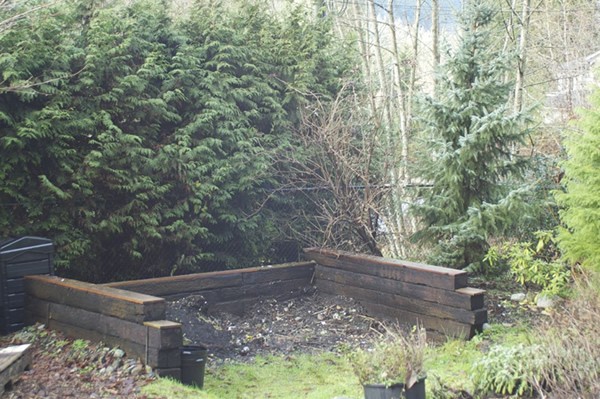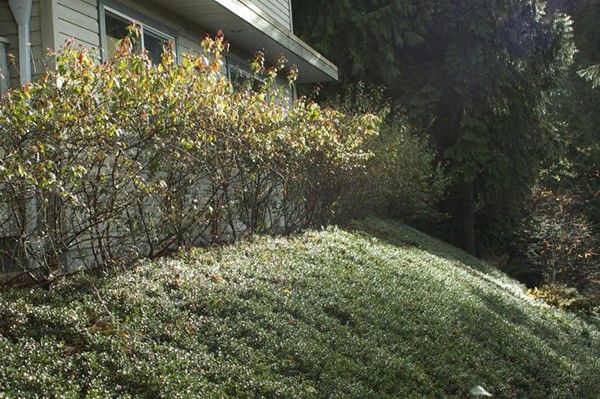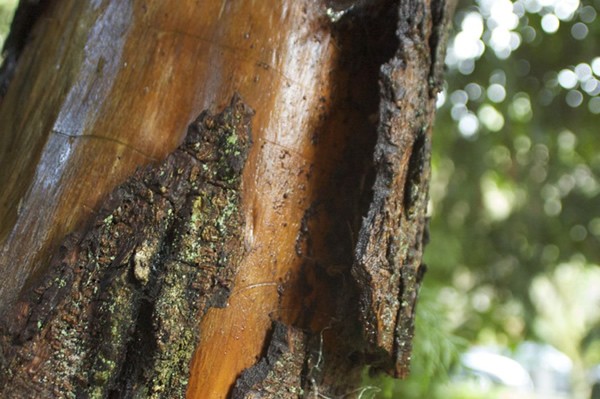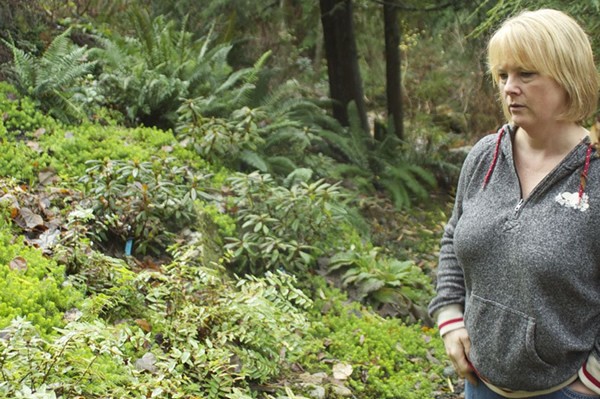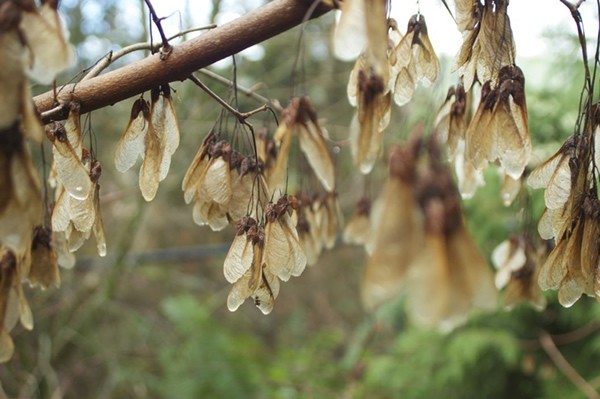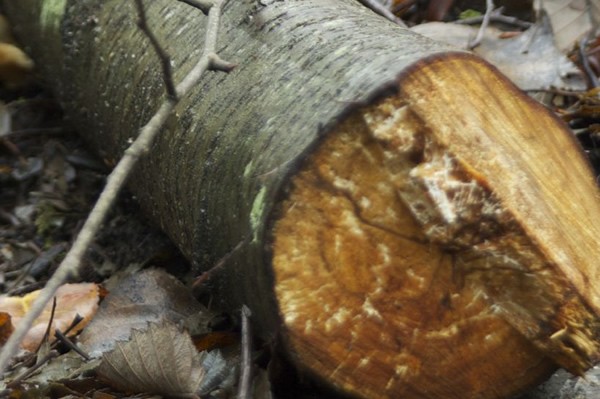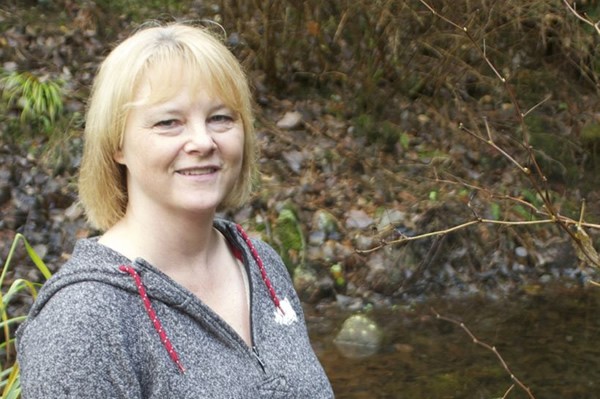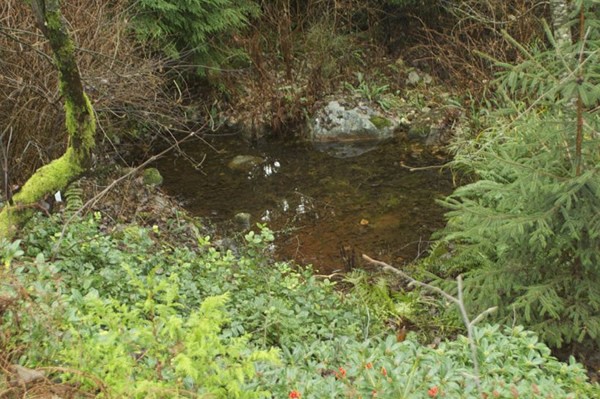Site Description
Name of the site: Ann Marie Oktaba’s property
Address: Anmore | Lower Mainland
Size: 1 acre
Type of crops: None, rural home
Managed property: 8 years
So that’s special when you know you are providing habitat for species that may not have habitat.
~Ann Marie Oktaba
Stewardship Practices Guides
The following guides are relevant to this project site
- Riparian Areas in Settled Landscapes
- Guidance for Restoration Activities in Riparian Areas
- Drainage Maintenance in Agricultural Waterways
Click to download the table for stewardship practices at the Oktaba site.
Stewardship project partner:
South Coast Conservation Program
Project Overview:
Ann Marie didn’t plan to become a frog champion when she moved in 2007 to her rural residential property. She first focused on cleaning up the yard, which had become “kind of a dumping ground; asphalt, blackberries, lamium was all the way down to the pond.” She and her husband pulled out garbage bags full of trash, tackled invasive plants and worked to replant the area with native species to control erosion and make the area more natural and friendly to birds and wildlife.
When we just came here I wasn’t really aware of what kind of wildlife to expect. The first few nights all we could hear were the pacific forest frogs chirping. In spring it resonates through the whole valley. The first few years we lived here you couldn’t get to sleep! . . . but now . . . it’s so exciting to hear them. Those sounds make you believe you are doing something right.
Key Stewardship Actions
- Control Invasive Species – Riparian Areas in Settled Landscapes
- Plant Native Vegetation – Guidance for Restoration Activities in Riparian Areas
- Protect Existing Riparian Areas – Riparian Areas in Settled Landscapes
Champions
Ann Marie Oktaba is the owner of the property.
Motivation
Ann Marie worked to make her property a welcoming home—for people and wildlife. She has heroically removed lamium and blackberries with her own hands, and planted over 30 types of native plants, covering about a third of her one acre property.
I wanted it to be a kind of natural oasis. We used to live in Coquitlam where we’d come home and go to a movie or dinner. But when we come home here we don’t want to leave. I love gardening, I love nature, I love wildlife. Just bringing it to where you live makes it special.
Ann Marie’s work had transformed the yard, but she felt that more could be done. She had discovered red-legged frogs on her property through the BC frog watch in 2010 and was concerned about the frog’s future when a few years later she heard about a proposed development next door. One day by chance she saw an advertisement from the South Coast Conservation Program (SCCP) in a local newspaper. The SCCP was offering a free environmental assessment for property owners. Ann Marie signed up and soon met Tamsin Baker, who came to the property to give advice on how to protect the habitat for the frogs. Ann Marie wanted to have a professional come to her property to help support the protection of the frogs’ sensitive breeding area.
I don’t often read the Tri City news but I happened to flip through and I read an article and thought, ‘This is what I need.’ A professional who knew what my next steps should be to come here and let me know if I should do something more.
Working with Tamsin, Ann Marie learned how to better protect to the Northern Red-Legged Frogs, a SARA species of special concern. She worked with the SCCP to enhance the habitat around her pond, installing woody debris and adding more native plants. As she has learned more about the frogs needs, she’s continued efforts to enhance their habitat. Now when trees fall on her property she doesn’t let her husband cut them up for firewood; instead she uses them as woody debris around the pond to improve the habitat quality. She also carefully removes excess grasses during the in-stream work window to assure that the bottom of her pond maintains an optimal level of mud for the frogs. She keeps tabs on egg masses and frog sightings in her pond, and has worked with local groups to identify and monitor other species such as Northwest and Long Toed Salamanders.
Finding out [that the frogs] are a species at risk stirred some passion in me to advocate for them and make sure their home is as protected as mine is.
Challenges
Even though Ann Marie was committed to making her property a welcoming natural habitat, she admits that signing up for the environmental assessment with the SCCP was scary. Perhaps they would scold her for having non-native plants or the way she was managing her property. But she found that the process was really positive and helpful, focusing on what was working and offering suggestions for making it better.
There were things she pointed out [to improve] but there was so much more positive than negative. And she really tries to engage with the landowner, saying ‘This is what you are really doing great and if you want to see this you could do this.’ And telling landowners, ‘I love this part of your yard.
Ann Marie was so satisfied with the assessment and consequent work with the SCCP that she recommended it to others in her community, organizing talks at a local garden club. She understands that many people are not comfortable having someone come to their property and evaluate what they are doing ‘right’ and ‘wrong.’
I thought everyone would want to do it; it’s free. But people come on their property and see invasive plants, they’re not doing this right, they’re reluctant. You were talking about emotional issues for agricultural land and government agencies coming in and telling them they are doing it wrong.
Some people did sign up through Ann Marie’s efforts and she is happy that she’s played a part in protecting more habitat. She worked via Tri-City Green Drinks, local garden clubs and local newspapers to get the word out and what people could do on their own property and about her concerns with the development.
It inspired me knowing there were others that had similar passions and to know I’m doing the right thing, there are people behind me. So now it’s not just a personal thing. I go to other places and am concerned about those areas too. I realized there’s more to it than just my little property.
But while she had protected the frogs’ habitat on her own property and even convinced a few others in her community to improve habitat on their properties, she learned of a bigger threat—a development project planned next door. She began researching the frogs’ habitat needs and the development project’s plans and became concerned. She began speaking at city council meetings and organized a petition going door to door to her neighbors. While at first many of her neighbors were skeptical when they talked with her many were supportive. They hadn’t known about the details of the development and were also concerned with the increase in density.
Outcomes
Her work on the neighboring development paid off. While she is still concerned about the frogs’ future, she got some concessions from the developers. The amphibian corridor and riparian buffer they will build is smaller and more fragmented than she’d hoped for, but without her work the developers would not have even known about the Northern Red Legged Frogs.
They put a little amphibian corridor in even though it’s very small and between houses. After some push and some support with the environmental community they even provided a buffer too. Albeit not 30 meters and it’s more of a triangle, or a funnel.
She’s also been able to bring more people on board with conservation on private lands.
It’s rewarding when you find out that people are interested in getting involved. And maybe you could protect a pond on someone else’s property. . .[or] one more yard might take their goldfish out of their pond and leave it as a habitat for frogs.
And on her own property, the frogs are a reminder that her hard work has paid off. She sees the Northern Red Legged Frogs every year from April to June and again in September and October. On a sunny day in the late spring, she can count on seeing one to three frogs when she visits her pond.
So that’s special when you know you are providing habitat for species that may not have habitat.
Stewardship Practices Menu
Learn more about Species at Risk
Stewardship Practices Case Studies
Fraser Valley & Lower Mainland Sites
Kootenay Sites
Okanagan Sites
Vancouver Island Sites
Contact Information
Find us on social media
LinkedIn: @StewardshipCentreBC YouTube: @stewardshipcentreforbc1047 Instagram: @StewardshipBC

